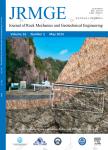Advances in joint roughness coefficient (JRC) and its engineering applications
作者机构:Nick Barton&AssociatesFjordveien 65cHavik Oslo1363Norway School of Civil EngineeingShijiazhuang Tiedao UniversityShijiazhuang050043China Rock Mechuanics InstituteNingbo UniversityNingbo315211China
出 版 物:《Journal of Rock Mechanics and Geotechnical Engineering》 (岩石力学与岩土工程学报(英文版))
年 卷 期:2023年第15卷第12期
页 面:3352-3379页
核心收录:
学科分类:08[工学] 080104[工学-工程力学] 0815[工学-水利工程] 0801[工学-力学(可授工学、理学学位)]
基 金:funded by the National Natural Science Foun-dation of China(Grant Nos.42177117 and 42207175) Zhejiang Provincial Natural Science Foundation(Grant No.LQ16D020001)
主 题:Joint roughness coefficient(JRC) Rock joints Roughness Shear strength Scale effect
摘 要:The joint roughness coefficient (JRC), introduced in Barton (1973) represented a new method in rock mechanics and rock engineering to deal with problems related to joint roughness and shear strength estimation. It has the advantages of its simple form, easy estimation, and explicit consideration of scale effects, which make it the most widely accepted parameter for roughness quantification since it was proposed. As a result, JRC has attracted the attention of many scholars who have developed JRC-related methods in many areas, such as geological engineering, multidisciplinary geosciences, mining mineral processing, civil engineering, environmental engineering, and water resources. Because of such a developing trend, an overview of JRC is presented here to provide a clear perspective on the concepts, methods, applications, and trends related to its extensions. This review mainly introduces the origin and connotation of JRC, JRC-related roughness measurement, JRC estimation methods, JRC-based roughness characteristics investigation, JRC-based rock joint property description, JRC s influence on rock mass properties, and JRC-based rock engineering applications. Moreover, the representativeness of the joint samples and the determination of the sampling interval for rock joint roughness measurements are discussed. In the future, the existing JRC-related methods will likely be further improved and extended in rock engineering.



